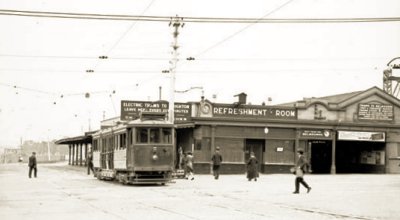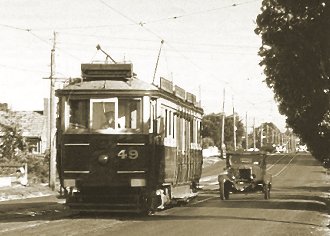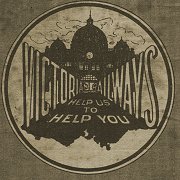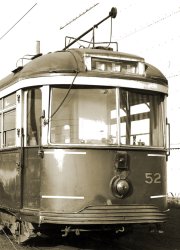Melbourne Tram Museum
- Follow Melbourne Tram Museum on Twitter
- Follow Melbourne Tram Museum on Facebook
- Follow Melbourne Tram Museum on Instagram
- Follow Melbourne Tram Museum on Pinterest
- Follow Melbourne Tram Museum on Tumblr
- Subscribe to Melbourne Tram Museum's RSS feed
- Email Melbourne Tram Museum
VR electric street railways
There was one electric tramway operator in Melbourne during the twentieth century that was not taken over by the M&MTB – Victorian Railways – giving Melbourne the unusual situation of having two different state government owned tramway operators.
VR operated two isolated tramways, one broad gauge (5'3") line from St Kilda railway station to Brighton Beach railway station, and one standard gauge line from Sandringham to Black Rock and Beaumaris.
St Kilda to Brighton Beach
The construction of the Brighton line was pushed through by Sir Thomas Bent, and opened for traffic on 5 May 1906. The rolling stock consisted of nine single truck motored tramcars and eight single truck trailers. This situation did not last long.
A fire at Elwood Depot broke out early in the morning of 7 March 1907, destroying the entire tram fleet as well as the car barn and offices. The fire was so intense that the previous day’s takings were reduced to a mass of silver and copper with streaks of gold. This event left VR in the invidious position of being unable to provide a tramway service. It managed to substitute an omnibus service the following day, as it had six steam chain-drive omnibuses lying idle. These vehicles had operated a railways bus service between Prahran and Malvern the previous year, which had proved unsuccessful. However, this was only a very short-term solution.
VR rapidly negotiated the purchase from NSW Government Tramways four Sydney ‘C’ class saloon tramcars (18-21) and three Sydney ‘D’ class California combination tramcars (15-17). These obsolete tramcars were removed from their standard gauge trucks and mounted on broad gauge trucks recovered from the fire. These cars were pressed into service by the end of March 1907. However, the narrow bodies were mounted high on the broad gauge trucks, and were most unpopular with both crews and passengers.
Meanwhile, Newport Workshops was working night and day to produce 14 replacement tramcars – seven California combination cars (1-7) and seven toastrack trailers (8-14), all of which were in service by the end of July 1907. In addition, two new car sheds were constructed at Elwood to replace the destroyed shed.
Once services were restored, residential development of the area moved ahead rapidly, and patronage increased likewise. As a result, the line was duplicated as far as the depot from St Kilda by 1913. The ex-Sydney cars were past their use-by date, so it was decided to acquire new tramcars. After a visit to Sydney, it was decided to base the new cars on the Sydney ‘J’ class, a single truck closed crossbench design. Nine of these cars (19-27) were introduced in 1913, and the ex-Sydney cars were retired.
The new cars were not popular, being criticised as always draughty, and not compatible with the ladies’ fashions of the day, which dictated long tight skirts. The resultant public uproar drove the formulation of a new plan of action, which resulted in the complete duplication of the line by 1915, and a plan to acquire modern, powerful tramcars, which also necessitated replacement of the steam powered Elwood power station (at the rear of the depot) with a local substation supplied by electric power transmitted from Newport Powerhouse.
Twenty new tramcars (28-47) were ordered from Newport Workshops, and delivery began in 1917. The new design was a four motor double bogie drop centre design which was to become common in Melbourne and other Australian cities. However, wartime restrictions delayed their entry into service until 1918, due to problems sourcing electrical equipment. These cars were also the first to be fitted with air brakes, which were to be retrofitted to all the other remaining cars. A third car shed was built at Elwood to house the new fleet.
Delivery of the VR standard bogie cars continued until 1923, but traffic did not increase to expectations. As a result, the last four partially built cars (44-47) were offered for sale to the M&MTB, but this offer was declined as the W class construction program was underway, and the M&MTB had no wish for yet another type of non-standard tramcar. Therefore, these four cars were not completed, leaving a gap in the rolling stock register between the broad gauge and standard gauge bogie cars.
 VR 38 leaving St Kilda station terminus on its way south to Brighton
Beach during the 1920s.
VR 38 leaving St Kilda station terminus on its way south to Brighton
Beach during the 1920s.- Photograph courtesy Public Record Office Victoria.
From this point on, investment in the Brighton Beach line stagnated, particularly in comparison to the development of the M&MTB system. The Railway Trams became known locally as ‘Ricketty Kates’, particularly the California combination cars. It was not until 1942 that any new tramcars were constructed for this line. These three new cars (52-54) were double bogie ‘luxury’ cars based on the M&MTB SW6 design, utilising electrical and traction equipment acquired for the four cancelled standard bogie cars. The California cars were officially withdrawn concurrent with the introduction of the new cars, but made an occasional sortie during peak hours if some of the bogie cars were off-line for maintenance up to 1956, when they were scrapped.
However, shortage of materials and finances during the Second World War prevented any further rehabilitation of the Brighton Beach line. In addition, the heavy loadings caused by wartime petrol rationing effectively drove the system into the ground, so that by war’s end things were in a parlous state.
After the introduction of the Melbourne suburban electric railway system, much of the maintenance work for the VR tramways was carried out at Jolimont Workshops. Items such as controllers, resistance grids and traction motors were overhauled in the electrical shop there, and were always in tip-top condition until the wind-down of the systems.
However, the effect of the war on the VR tramways left their mark. One former Jolimont Workshops tradesman [1] from the 1940s recollected that the bottom of the motor casings were always gleaming polished metal – in some areas the tram rails had sunk so far into the road surface that it continually rubbed the motor casing bottoms bare. The degradation in road surface became an item of constant dispute with the municipalities of St Kilda and Brighton.
The post-war period saw competing bus routes introduced, together with the removal of petrol rationing and increased us of private motor vehicles. Industrial action, both direct and indirect, impacted on the Brighton line. Shortages in coal supplies due to incessant industrial action saw shortages of power. This meant that long headways existed between services. Direct industrial action was also frequent, one dispute causing cessation of services for 55 days. All these factors caused reductions in traffic receipts, which discouraged further capital investment.
From 1947 onwards, there were endless reviews, until it was decided in 1953 by VR that the Brighton line was to be closed. The largest-ever public meeting in Elwood was held to oppose the closure. This level of opposition caused some re-evaluation of the closure proposal, and there were furious negotiations behind the scenes between the municipalities, VR and other transport bodies. VR attempted to off-load their tramways on the M&MTB, which politely declined, and as there was no finance available for rehabilitation, in 1956 a decision was made to close the line beyond Elwood Depot.
The first section to close was between Brighton Beach and Park Street Middle Brighton, on 1 January 1956, car 42 operating the last service. Exactly six months later, bogie no 30 did the honours for the section between Park Street and Elwood Depot. The truncation of the line caused patronage to fall even further than expected, and it became impossible to operate it with any semblance of economic sanity. In addition, VR transferred £195,000 to Brighton Council for restoration of the roadway.
Attempts were made to address this income shortfall, partly by transfer in 1957 of the two one-man cars (50 and 51) from the closed Sandringham line after conversion to broad gauge. However, the union objected to this initiative, and black-banned their use in normal service, their only use being for an AETA tour.
In 1958 it was decided to totally close the line. The final day of operation was 28 February 1959, the final run from St Kilda being operated by bogie 28, arriving at Elwood Depot at 12:35 am, to be welcomed by about 1000 people singing Auld Lang Syne. An era had passed.
The three luxury cars (52-54) were purchased by the M&MTB, which converted two of them to standard gauge, number 54 being finally scrapped in 1967 without further use. After M&MTB service, number 52 was acquired by the TMSV, and the body of 53 was donated to the ARHS North Williamstown Railway Museum; this latter car has been restored to running condition, and is expected to be on display at Hawthorn Depot in the near future (as at 2008). The rest of the cars were disposed of from Elwood Depot, most ending up in suburban backyards or as sheds in the country. Number 41 has been restored to near original condition by the MTPA (Melbourne Tramcar Preservation Association), crossbench 20 was purchased by R.H. Prentice on closure and is now owned by the VicTrack, but is awaiting restoration. The body of 35 was recovered for restoration by SPER (South Pacific Electric Railway) (stored at Bylands – 2003), and finally the body of 34 has been owned by the TMSV since closure of the Brighton line.
After the closure of the line, the VR Commissioners paid the St Kilda City Council the sum of £199,000 to cover removal of the tramway and restoration of the road surface.
There is now almost no sign that there was ever a tram line between St Kilda and Brighton Beach, the only surviving structure being a tram shelter on the west side of Beach Road in Brighton. It is also rumoured that the H crossing with the Point Ormond line survives under a roundabout.
The land for Elwood Depot at the corner of St Kilda Street and Head St was excised from Elsternwick Park, but a covenant was placed upon the title such that in the event of the closure of the tramway, the excised land would be returned to the park. However, this covenant was no longer in place at the time of closure. The rear part of the site where the power house had stood was sold for housing, most of the rest of the site being leased to the Brighton-St Kilda Bus Lines as their depot (using two of the tram sheds for under cover storage), with the corner being used for a service station.
When the private bus company was purchased by the government in the 1980s, the bus depot returned to public ownership until the mid 1990s, when it was finally sold. The two remaining tram sheds were demolished to make way for townhouses.
From time to time prior to the Second World War, there were proposals floated to extend the Brighton line along South Road to Moorabbin railway station, but these were never implemented. Instead, during its life it remained an anomaly – the only broad gauge urban electric tramway in Australia.
Sandringham to Black Rock and Beaumaris
In 1887 the Brighton railway line was extended to Sandringham. This was the height of the notorious Victorian land boom, and Moorabbin Shire Council (of which the future Sir Thomas Bent was the Chairman) was keen to ensure development of the area south of Sandringham. It therefore sought and received permission to build two tramways with a total length of nine and a half miles. The lines were to run from Sandringham station along the coast road to Beaumaris and thence inland to Cheltenham railway station, with a branch from Beaumaris continuing down the coast road to Mordialloc.
A contract was signed between the Shire Council and the Beaumaris Tramway Company (BTC) in February 1888 for the latter to construct a horse tramway and operate it for a lease period of 30 years. The Sandringham to Cheltenham route was built at a cost of £20,000 and opened that Christmas. The Mordialloc branch line was never built.
However, the hopes of the Shire Council and the BTC were not to be met. The land boom bubble burst in 1891, and development of much of the area beyond Black Rock ceased for several decades. The BTC was effectively kept afloat by holiday traffic, and managed to stagger on until 1912, when it abandoned the Beaumaris to Cheltenham section. In the middle of 1914 the BTC folded and ceased operation – unsung and quickly forgotten.
However, the area between Sandringham and Black Rock was undergoing significant development from the first decade of the twentieth century, when a public association was formed to lobby for an extension of the Sandringham railway, local residents being unhappy with the service supplied by the BTC. The Parliamentary Standing Committee on Railways recommended an extension of the railway to South Sandringham in 1910, but this was later vetoed as a result of the projected high cost of land resumptions.
A recommended alternative to this proposal was issued in both 1913 and 1914 for an electric tramway from Sandringham to Black Rock using an inland route, as it was felt that use of the coast road would spoil the visual amenity of the coastal reserves. The relevant act was passed in November 1914, but although this tramway was to be owned and operated by VR, it was to be standard gauge rather than broad in order to cater for any future connection to the main Melbourne system. It should be noted that this was to be the first use of standard gauge by VR.
Like much tramway construction in Melbourne at the time, significant problems were encountered in obtaining both rail and electrical equipment, delaying opening for over four years until 10 March 1919.
The small three-road depot was built in Sandringham railway station yard. The depot fan connected with the down track in Bay Street. The line was almost entirely double track, except for the short section between the depot junction and terminus outside the main Sandringham railway station building. Six of the crossbench cars (22-27) and six trailers (8-13) were converted to standard gauge and transferred from Elwood to Sandringham to operate the tramway.
The stationmaster at Sandringham was placed in charge of traffic of the tramway (surely one of the most unusual duties of a VR stationmaster), but staff from Elwood Depot undertook maintenance of track and rolling stock.
To cater for an increase in patronage as a result of the electrification of the Sandringham railway line, the crossbench cars were joined in 1921 by four new bogie tramcars (48-51) identical to those operating the Brighton line, but on standard gauge bogies. The six trailers were scrapped as they were no longer required – as was the remaining broad gauge trailer at Elwood.
Meanwhile the residents of Beaumaris were smarting from their lack of public transport, and lobbied for an extension of the Black Rock to their suburb. The Parliamentary Standing Committee considered this proposal in 1916 and again in 1919, but was not positive about the financial future of the extension. Eventually, an inland route was recommended for when the economy improved, and there the matter remained for some time.
It was not until 1925 that an agreement was struck between VR and Sandringham City Council for the latter to provide a £2,000 annual operating subsidy to the proposed extension for a period of five years. As a result, construction of the Beaumaris extension commenced, and the single-track line was opened on 1 September 1926 by bogie car number 51.
However, the hopes of the local municipality were yet again dashed as the hoped for residential development did not occur, due to the almost total lack of local utilities such as power, gas or water. The extension (known as the ‘Bush Tramway’) ran at a heavy loss despite the operating subsidy, and five years to the day the crossbench tram number 25 returned from the last trip on the Beaumaris extension on 31 August 1931.
Despite the closure of the Beaumaris extension, VR were not recouping their operating costs. Therefore it borrowed Y1 number 613 from the M&MTB in order to experiment with one man operation of tramcars. This experiment was successful – bogie cars 50 and 51 were lengthened and modified to a Peter Witt format (similar to the Y1) for one-man operation in the M&MTB’s Preston Workshops in 1938 and 1934 respectively. In 1938 four crossbench cars (22, 24-25, 27) were scrapped, the remaining two being retained as standby cars.
 VR No 49 at Black Rock in the 1950s.
VR No 49 at Black Rock in the 1950s.- Photograph Jim Seletto.
Like the Brighton line, the Sandringham-Black Rock tramway enjoyed record traffic during the Second World War, actually recording its first profits. However, maintenance did not keep pace, and the tramway ended the war very run down. In June 1945 VR announced that it intended closing the line and replacing it with an omnibus service. This sparked off the most passionate and sustained public campaign in Australia to retain a tramway, and all sectors of the local community united in an attempt to keep the line open. They were even pushing for its connection with the main Melbourne system (via the East Brighton line).
Unfortunately, after an eleven year battle, the tramway became too run down to continue operation, and the line closed on 5 November 1956, the last trip being operated by number 51. The tramway was replaced after 37 years operation with a VR operated bus route. To cater for removal of the tramway and replacement of the road surface, VR paid Sandringham City Council the sum of £20,000.
The only reminder of the former presence of the Sandringham tramline is the former car barn located at the railway station. This was converted for use as a bus depot and maintenance workshop for the replacement VR bus service, but ownership has now passed to a private bus operator, Melbourne Bus Link, as a result of the Kennett government public transport privatisations. However, it cannot be accessed from Bay Street, as a row of shops has been built across the former entrance. The late horse tramway is remembered by the name of a suburban street that it once used – Tramway Parade, Beaumaris.
As to the tramcars that operated on the Sandringham line, the bodies of numbers 50 and 51 were for many years in Marysville, but have now disappeared. The bodies of numbers 48 and 49 were recently acquired by SPER from the Canberra Workingman’s Club for prospective preservation. Like the Sandringham line itself, none of the single truck tramcars that operated on this line have survived.
Bibliography
Cross, N., Budd, D., and Wilson, R. (1993) Destination City (Fifth
Edition), Transit Australia Publishing
Harrigan, L. J. (1962) Victorian Railways to ’62, Victorian
Railways
Marshall-Wood, L. (1966) The Brighton Electric Line, Traction
Publications
Footnote
[1] Personal recollection of the late F.R. Madigan as recounted to the author (1997).

